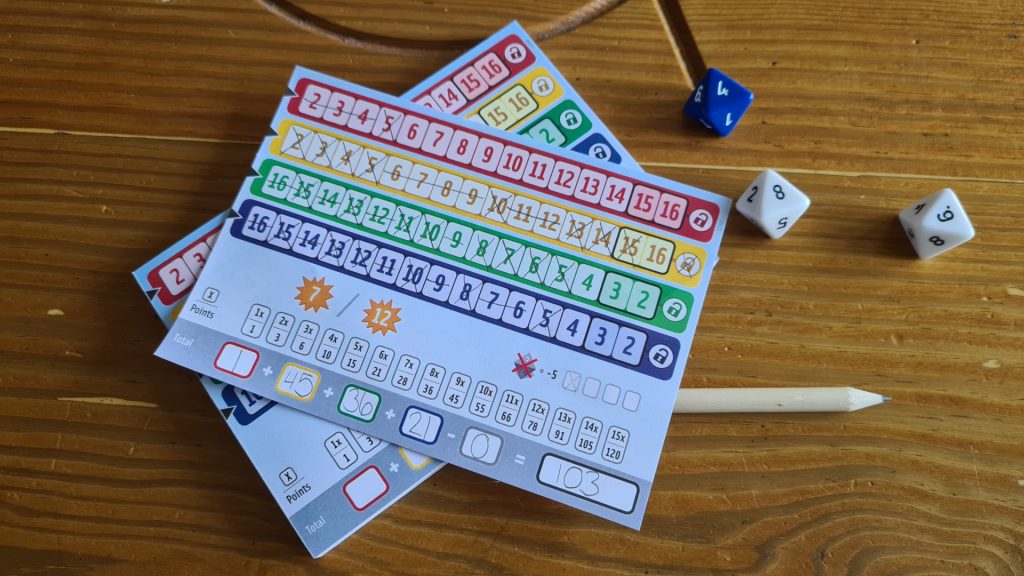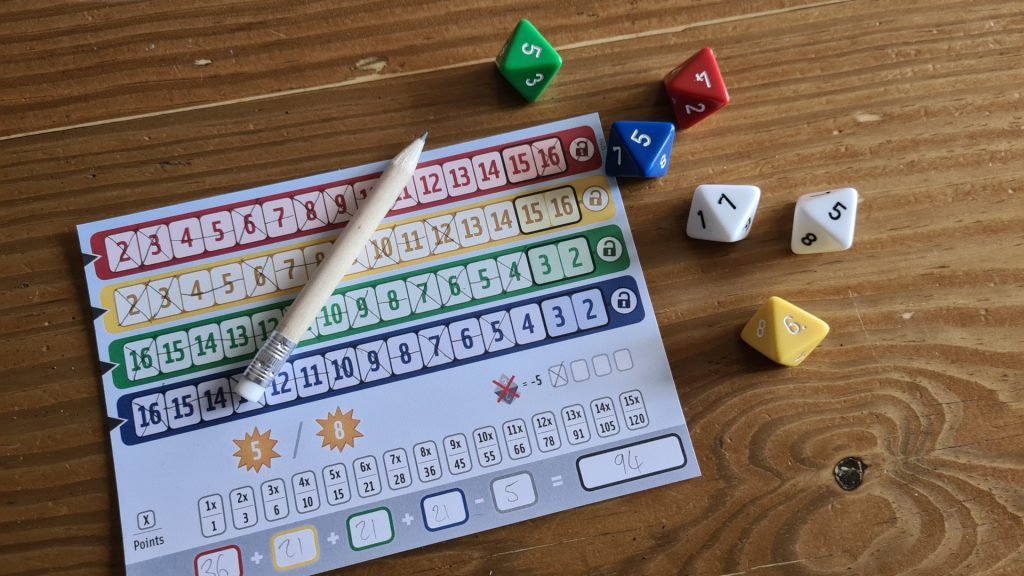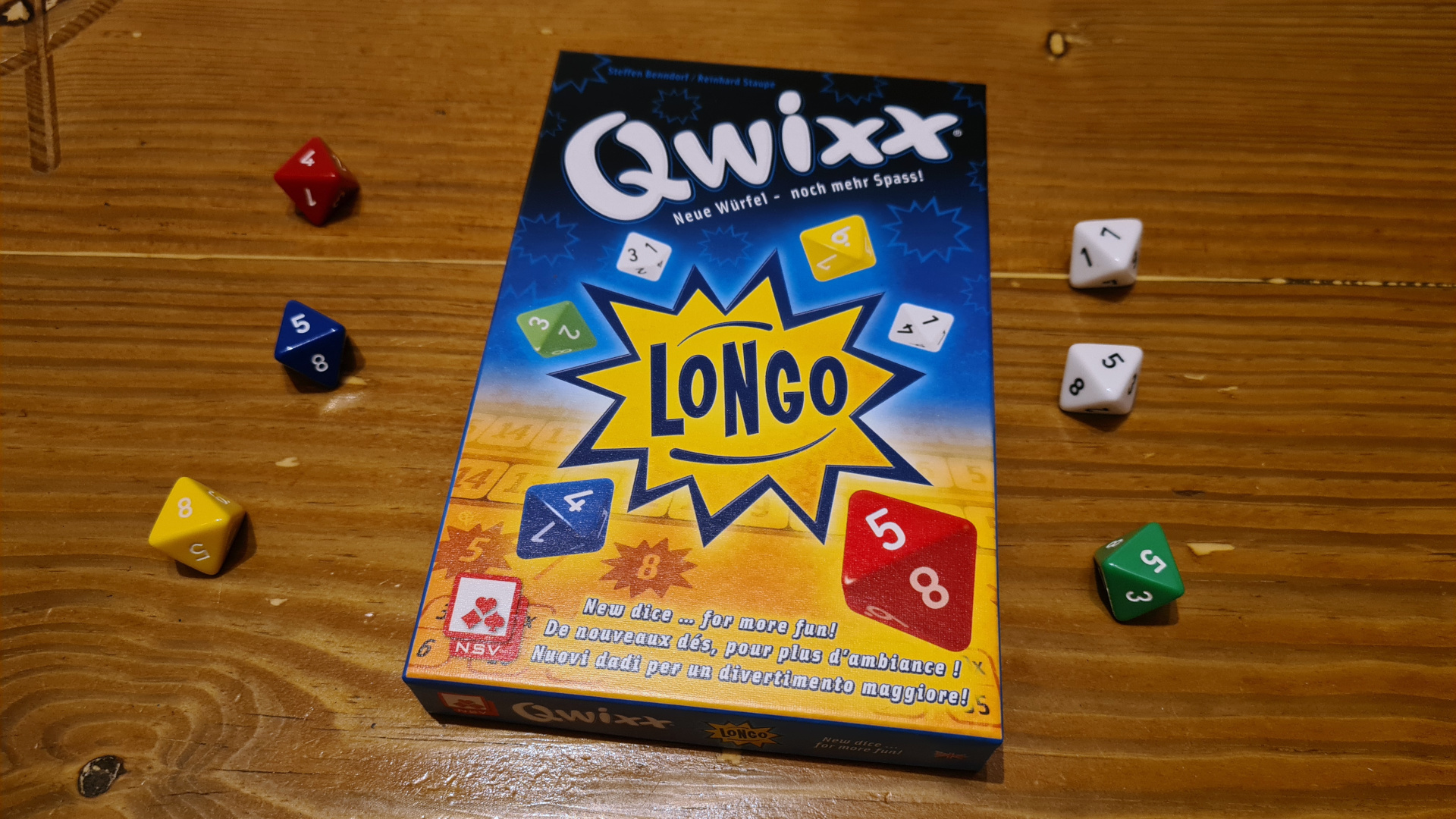Qwixx Longo is a roll and write game from German publisher Nürnberger-Spielkarten-Verlag (NSV). Designed by Steffen Benndorf and Reinhard Staupe, the game sees 2 – 5 players rolling dice and filling in their scoresheets – much like its predecessor Qwixx. Taking around 15 minutes to play, should this be rolling into your collection? Let’s find out!
Passing everyone a scoresheet and pencil, the new 8 sided dice are given to one player. Qwixx Longo is then already set up. The design of the scoresheets is such that there are 4 coloured rows. Unlike the original the numbers on these rows go higher. The rows feature labeled boxes going from 2 to 16 in red and yellow and from 16 to 2 in green and blue. As a rule players will be crossing off these boxes from left to right. It’s fine to skip numbers but players are then unable to cross off any in the future that they’ve passed over.
Played over a series of turns, each sees the active player roll the dice. All players are then able to use the combined value of the two white dice to cross off a value on their scoresheet. Initially, this can be on any of the four coloured rows. In a twist from Qwixx, each player has two “lucky” numbers, with different scoresheets having different lucky numbers. If the summed value of the white dice equals one of your lucky numbers you can instead cross off the next available space of the row with the fewest crossed off spaces.
Then, the active player can combine either of the white die values with one of the four coloured dice, crossing off that number on the appropriate colour row. The active player must choose to do one of these options, else they mark down that as a failed roll, worth -5 points at the end of the game. Note that this is only for the active player. All other players are free to use the combined value of the white dice or not, with no repercussions.

Players can only fill in the rows from left to right, and when skipping over numbers it is suggested to put a line through them. It’s not necessary. Still, for the first play of a Qwixx title it’s there as a little reminder. Skipped numbers are not directly bad for the player but present opportunities missed. As the aim is to cross off as many numbers in a row as possible, skipping too many means the player won’t gain too many victory points.
Once a player has 6 numbers crossed off on a row, and the dice roll allows for it, they can choose to cross off one of the rightmost two numbers in a row. For example, if a player has 6 crossed off numbers on the yellow row, and the white dice totalled 15 or 16, they could cross off one of the final boxes of the yellow row. This player also gets to cross off the padlock for the yellow row boosting their score. When this occurs, the coloured die associated with the row is removed from play and no one can cross off numbers in that row for the rest of the game.
Once everyone has chosen whether or not to use the value to cross something off, the game continues with the next player becoming the active player. The game ends when one of two conditions is met. If either two colours are locked at the end of a turn or one player has taken their 4th failed roll, the game is over. Technically it is possible at the end of a turn to have more than two rows locked, though this is rare, with the game ending as normal. At this point players determine their score for each row. Using the table on the scoresheet they convert the amount of crossed off boxes into a points value. Subtracting any negative points from failed rolls, the player with the most points wins.
Just like in the original, the players’ aim in Qwixx Longo is simple. It makes it very easy to teach, as the premise is to cross off as many number spaces as possible. This helps the game very quickly hit the table and for play to begin. There is an extra step in Qwixx Longo to this process, explaining the lucky numbers option players have. Thankfully, this adds only a handful of extra seconds to the teach.

One rule is unfortunately easy to forget and disappointingly the scoresheets do little to remind players. Before one of the last numbers can be crossed off a row must already have 6 crossed off numbers. Despite the padlock symbol on the scoresheet, there isn’t anything to remind players that it is specifically 6 numbers they needed to cross off. Especially as this differs from the original, in which it was 5 numbers, just a small six somewhere near the zone of the final 2 numbers would have saved a skim of the rulebook or two.
All six dice are rolled on opponents’ turns but everyone else around the table are only interested in the two white dice, compounded by the lucky numbers. Between turns this gives players something to keep them involved but it certainly does feel like a lesser turn. This is perhaps of the quantity of dice that you simply don’t care about, with the 4 coloured dice only usable by the active player.
Any game with dice is going to have a luck factor. With the active player having a bigger selection of dice, Qwixx Longo does lose some of the typical roll and write logic of everyone using the same dice pool. Furthering this, the lucky numbers which each player have are unique. Adding another layer of luck of the dice makes this more apparent. The concept of the lucky numbers is a strong one though, it would just feel fairer to all players if everyone had the same numbers.
Qwixx Longo takes the logics of Qwixx and slightly changes things up. The move to 8 sided dice makes the game stand out slightly in the sea of roll and writes where six sided dice are aplenty. Yet, gameplay wise it makes much less impact compared to the lucky numbers. One slightly cheeky thing is that while the box says 2 – 5 players only 4 pencils are included, though obviously this doesn’t impact the gameplay. Overall, Qwixx Longo is a bit of a sidestep from the original rather than anything new. Nevertheless, for those who don’t own the original then it’s an interesting puzzle of a number based roll and write.
(Editor’s Note: Qwixx Longo was provided to us by Coiledspring Games. Check out the official webpage here.)

